Remove the oil cover (A) and gasket (B).
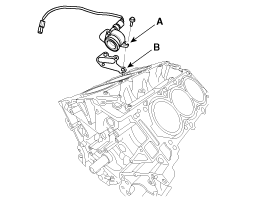
Use fender covers to avoid damaging painted surfaces.
To avoid damage, unplug the wiring connectors carefully while holding the connector portion.
Mark all wiring and hoses to avoid misconnection.
Inspect the timing chain before removing the cylinder head.
Turn the crankshaft pulley so that the No.1 piston is at top dead center (TDC).
Remove the engine assembly from the vehicle.
(Refer to Engine And Transmission Assembly - "Engine And Transmission Assembly")
Remove the drive plate and adapter plate.
(Refer to Cylinder Block - "Drive Plate")
Attach the engine to engine stand for disassembly.
Remove the exhaust manifold.
(Refer to Intake And Exhaust System - "Exhaust Manifold")
Remove the intake manifold.
(Refer to Intake And Exhaust System - "Intake Manifold")
Remove the timing chain.
(Refer to Timing System - "Timing Chain")
Remove the water temperature control assembly.
(Refer to Cooling System - "Water Temperature Control Aassembly")
Remove the cylinder head.
(Refer to Cylinder Head Assembly - "Cylinder Head")
Remove the oil pump.
(Refer to Lubrication System - "Oil Pump")
Remove the oil filter body.
(Refer to Lubrication System - "Oil filter body")
Remove the oil cover (A) and gasket (B).

Remove the water jacket seperator.
(Refer to Cylinder Block - "Water Jacket Seperator")
Remove the knock sensor (A).
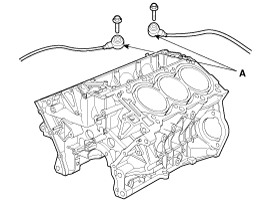
Remove the upper oil pan.
(Refer to Lubrication System - "Oil Pan")
Remove the baffle plate (A).
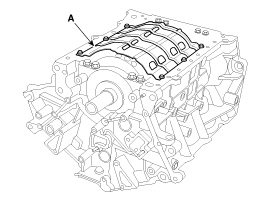
Remove the rear oil seal case (A).
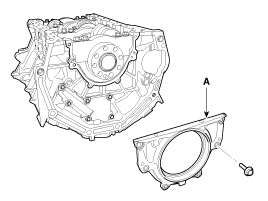
Remove the oil drain cover (A) and gasket (B).
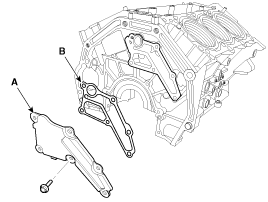
Check the connecting rod end play.
(Refer to Cylinder Block - "Piston And Connecting Rod")
Check the connecting rod cap oil clearance.
(Refer to Cylinder Block - "Piston And Connecting Rod")
Remove the piston and connecting rod assemblies.
(Refer to Cylinder Block - "Piston and Connecting Rod")
Remove the crankshaft main bearing cap and check oil clearance.
(Refer to Cylinder Block - "Crankshaft")
Check the crankshaft end play.
(Refer to Cylinder Block - "Crankshaft")
Remove the crankshaft.
(Refer to Cylinder Block - "Crankshaft")
Remove the oil jets (A).
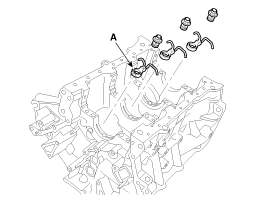
Remove the gasket material.
Using a gasket scraper, remove all the gasket material from the top surface of the cylinder block.
Clean the cylinder block
Using a soft brush and solvent, thoroughly clean the cylinder block.
Inspect the top surface of the cylinder block for flatness.
Using a precision straight edge and feeler gauge, measure the surface contacting the cylinder head gasket for warpage.
Flatness of cylinder block gasket surface
Standard : Less than 0.05 mm (0.0020 in.),
Less than 0.02 mm (0.0008 in.) / 150 x 150
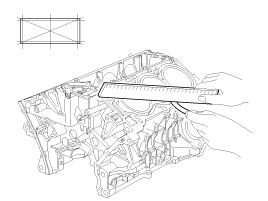
Inspect cylinder bore diameter.
Visually check the cylinder for vertical scratchs.
If deep scratches are present, replace the cylinder block.
Inspect cylinder bore diameter.
Using a cylinder bore gauge, measure the cylinder bore diameter at position in the thrust and axial directions.
Standard diameter :
92.00 ~ 92.03 mm (3.6220 ~ 3.6232 in.)
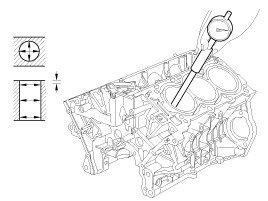
Check the cylinder bore size code on the cylinder block.
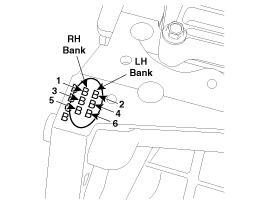
Class | Size code | Cylinder bore inner diameter |
A | A | 92.00 ~ 92.01 mm (3.6220 ~ 3.6224 in.) |
B | B | 92.01 ~ 92.02 mm (3.6224 ~ 3.6228 in.) |
C | C | 92.02 ~ 92.03 mm (3.6228 ~ 3.6232 in.) |
Oversize pistons should be selected according to the largest bore cylinder.
Identification Mark | Size |
0.1 | 0.1 mm (0.004 in) |
0.25 | 0.25 mm (0.010 in) |
The size of piston is stamped on top of the piston.
Measure the outside diameter of the piston to be used.
According to the measured O.D(Outer Diameter), calculate the new bore size.
New bore size = piston O.D + 0.03 to 0.05 mm (0.0012 to 0.0020 in) (clearance between piston and cylinder) - 0.01 mm (0.0004 in) (honing margin.)
Bore each of the cylinders to the calculated size.
To prevent distortion that may result from temperature rise during honing, bore the cylinder holes in the firing order.
Hone the cylinders, finishing them to the proper dimension (piston outside diameter + gap with cylinder).
Check the clearance between the piston and cylinder.
Standard : 0.03 ~ 0.05 mm (0.0012 ~ 0.0020 in)
When boring the cylinders, finish all of the cylinders to the same oversize. Do not bore only one cylinder to the oversize.
Install the oil jets (A).
Tightening torque
27.5 ~ 31.3 N.m (2.8 ~ 3.2kgf.m, 20.2 ~ 23.1lb-ft)

Install the cranksfhat.
(Refer to Cylinder Block - "Crankshaft")
Install the crankshaft main bearing cap and check oil clearance.
(Refer to Cylinder Block - "Crankshaft")
Check the crankshaft end play.
(Refer to Cylinder Block - "Crankshaft")
Install the piston and connecting rod assemblies.
(Refer to Cylinder Block - "Piston and Connecting rod")
Check the connecting rod end play.
(Refer to Cylinder Block - Piston And Connecting Rod")
Install the oil drain cover(A) with a new gasket (B).
Tightening torque :
9.8 ~ 11.8 N.m (1.0 ~ 1.2 kgf.m, 7.2 ~ 8.7 lb-ft)

Install the rear oil seal case(A).
Tightening torque :
9.8 ~ 11.8 N.m (1.0 ~ 1.2 kgf.m, 7.2 ~ 8.7 lb-ft)

Clean the sealing face before assembling two parts.
Remove harmful foreign materials on the sealing face before applying sealant
Before assembling rear oil seal case, the liquid sealant THREE BOND 1217H should be applied to the rear oil seal case.
The part must be assembled within 5 minutes after sealant was applied.
Apply sealant to the inner threads of the bolt holes.

Install the rear oil seal.
(Refer to Cylinder Bolck - "Rear Oil Seal")
Install the baffle plate.
Install and uniformly tighten the baffle plate bolts, in several passes, in the sequence shown.
Tightening torque :
9.8 ~ 11.8 N.m (1.0 ~ 1.2 kgf.m, 7.2 ~ 8.7 lb-ft)
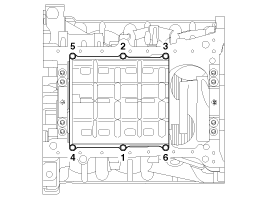
Install the upper oil pan.
(Refer to Lubrication System - "Oil Pan")
Install the knock sensor (A).
Tightening torque :
15.7 ~ 23.5 N.m (1.6 ~ 2.4 kgf.m, 11.6 ~ 17.3 lb-ft)

Install the water jacket seperator.
(Refer to Cylinder Block - "Water Jacket Seperator")
Remove the oil cover (A) and gasket (B).
Tightening torque :
9.8 ~ 11.8 N.m (1.0 ~ 1.2 kgf.m, 7.2 ~ 8.7 lb-ft)

Install all other parts in reverse order of removal.
In case the cylinder block is replaced with a new one, select the proper crankshaft main bearing and the piston according to the crankshaft journal bore mark and the cylinder bore mark on the cylinder block.
Crankshaft main bearing selection
(Refer to Cylinder Block - "Crankshaft")
Piston selection
(Refer to Cylinder Block - "Piston and Connecting Rod")